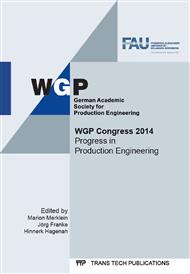p.83
p.91
p.99
p.107
p.115
p.123
p.131
p.137
p.145
Dry and Residue-Free Cutting with High-Pressure CO2-Blasting
Abstract:
Jet cutting with high-pressure CO2 jets has the potential for a dry and residue-free machining of materials. However, a high-pressure CO2 blasting plant as well as experimental expertise for the continuous jet cutting with high-pressure CO2 at atmospheric conditions are not available. A pilot plant for the continuous jet cutting with liquid carbon dioxide was developed and realized at the Fraunhofer-Institute for Production Systems and Design Technology. Identical cutting tests were carried out in polyurethane blocks of different Shore D-hardness and density with high-pressure CO2 and water jets. Based on the first results in polyurethane blocks the tests were extended to cutting carbon fibre reinforced plastic plates with the high-pressure CO2 jet. Finally the possibilities and limits of the high-pressure CO2 jet cutting were summarised.
Info:
Periodical:
Pages:
115-122
Citation:
Online since:
September 2014
Authors:
Keywords:
Price:
Сopyright:
© 2014 Trans Tech Publications Ltd. All Rights Reserved
Share:
Citation:


